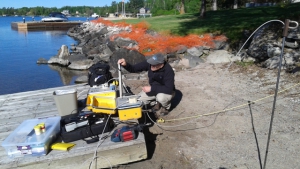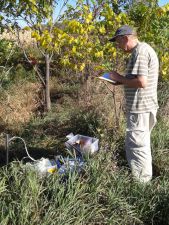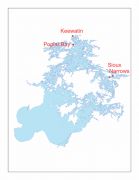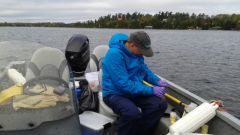Overview
 Sampling nearshore groundwater at Kenora (Keewatin).This project assesses whether shoreline developments in Lake of the Woods cause nutrients such as phosphorus, to enter the lake, potentially leading to harmful algal blooms. The focus is nutrients entering from septic systems in areas near the lake. Groundwater and surface water samples are analyzed for various indicators of water quality, including nutrients and wastewater tracers. Comparison of analyses of septic wastewater and groundwater indicate that much of the phosphorus is removed as the wastewater seeps below ground and flows toward the lake. Modeling and interpretation of the data is ongoing.
Sampling nearshore groundwater at Kenora (Keewatin).This project assesses whether shoreline developments in Lake of the Woods cause nutrients such as phosphorus, to enter the lake, potentially leading to harmful algal blooms. The focus is nutrients entering from septic systems in areas near the lake. Groundwater and surface water samples are analyzed for various indicators of water quality, including nutrients and wastewater tracers. Comparison of analyses of septic wastewater and groundwater indicate that much of the phosphorus is removed as the wastewater seeps below ground and flows toward the lake. Modeling and interpretation of the data is ongoing.
Location of Study
Lake of the Woods, various sites in northern sectors, including Poplar Bay, Sioux Narrows, and Kenora (Keewatin).
Researcher Profile
Da  Dale Van Stempvoort, lead ECCC researcher on nearshore phosphorus loadsle Van Stempvoort, Research Scientist with Environment and Climate Change Canada (ECCC)
Dale Van Stempvoort, lead ECCC researcher on nearshore phosphorus loadsle Van Stempvoort, Research Scientist with Environment and Climate Change Canada (ECCC)
I am Environment and Climate Change Canada’s lead on groundwater for the Great Lakes Water Quality Agreement. My current research is on contaminants in groundwater and surface water, including those of emerging concern. This includes assessing the effect of contaminants, by analyzing chemicals that act as tracers in wastewater. Recently, my research included a focus on nutrients, such as phosphorus, in groundwater and surface water.
Description of Study
This research addresses a need for more information on phosphorus releases related to harmful algal blooms in Lake of the Woods. It will assess the extent to which shoreline developments are contributing to nutrients entering the lake in nearshore regions. Phosphorus is a nutrient, present in waste waters (as well as other sources) typically responsible for algal bloom issues, so it is important to understand its potential sources.
The major components of this study will examine phosphorus entering the lake from cottage septic systems at Poplar Bay, and  Nearshore phophorus loading study locations on Lake of the Woodsfrom other septic systems at Sioux Narrows. As part of this work, we also sampled nearshore groundwater and surface water in an urban setting at Kenora (Keewatin).
Nearshore phophorus loading study locations on Lake of the Woodsfrom other septic systems at Sioux Narrows. As part of this work, we also sampled nearshore groundwater and surface water in an urban setting at Kenora (Keewatin).
Eight sampling trips were carried out between the fall of 2016 and the fall of 2018. We took samples of groundwater and surface water at all locations analyzing them for various indicators of water quality. This included phosphorus as well as substances that act as tracers of wastewater. The artificial sweetener acesulfame (also known as Ace-K) is a good tracer of septic wastewater because it tends to stay dissolved in water, it doesn’t break down easily, and it is present in waste water at levels that are easily detectable.
Preliminary Results
 Sampling surface water at Poplar Bay. Our preliminary results show that the shallow groundwater in Poplar Bay has relatively high levels of Ace-K compared to samples from other places in Lake of the Woods, indicating noticeable effects of waste water on this restricted bay. However, these samples also tended to have some of the lowest phosphorus levels compared to the other Lake of the Woods samples. We do not see evidence of strong phosphorus contamination from septic systems in the shallow waters of this bay. Our preliminary results suggest that phosphorus in septic wastewater is largely removed as it seeps below ground and flows toward the lake.
Sampling surface water at Poplar Bay. Our preliminary results show that the shallow groundwater in Poplar Bay has relatively high levels of Ace-K compared to samples from other places in Lake of the Woods, indicating noticeable effects of waste water on this restricted bay. However, these samples also tended to have some of the lowest phosphorus levels compared to the other Lake of the Woods samples. We do not see evidence of strong phosphorus contamination from septic systems in the shallow waters of this bay. Our preliminary results suggest that phosphorus in septic wastewater is largely removed as it seeps below ground and flows toward the lake.
Sampling of shallow groundwater along a shoreline at Kenora indicated some high levels of phosphorus. While wastewater is not an important contributor of phosphorus at this shoreline, there are other possible sources.
Next Steps
Over the next year, more samples of surface water and groundwater will be collected at Poplar Bay and Sioux Narrows to expand our insight into the water quality, with an ongoing focus on phosphorus, other nutrients, and wastewater tracers. Collaboration with other Environment and Climate Change Canada scientists at Poplar Bay will assist in the modeling and interpretation of the data collected in this study.
